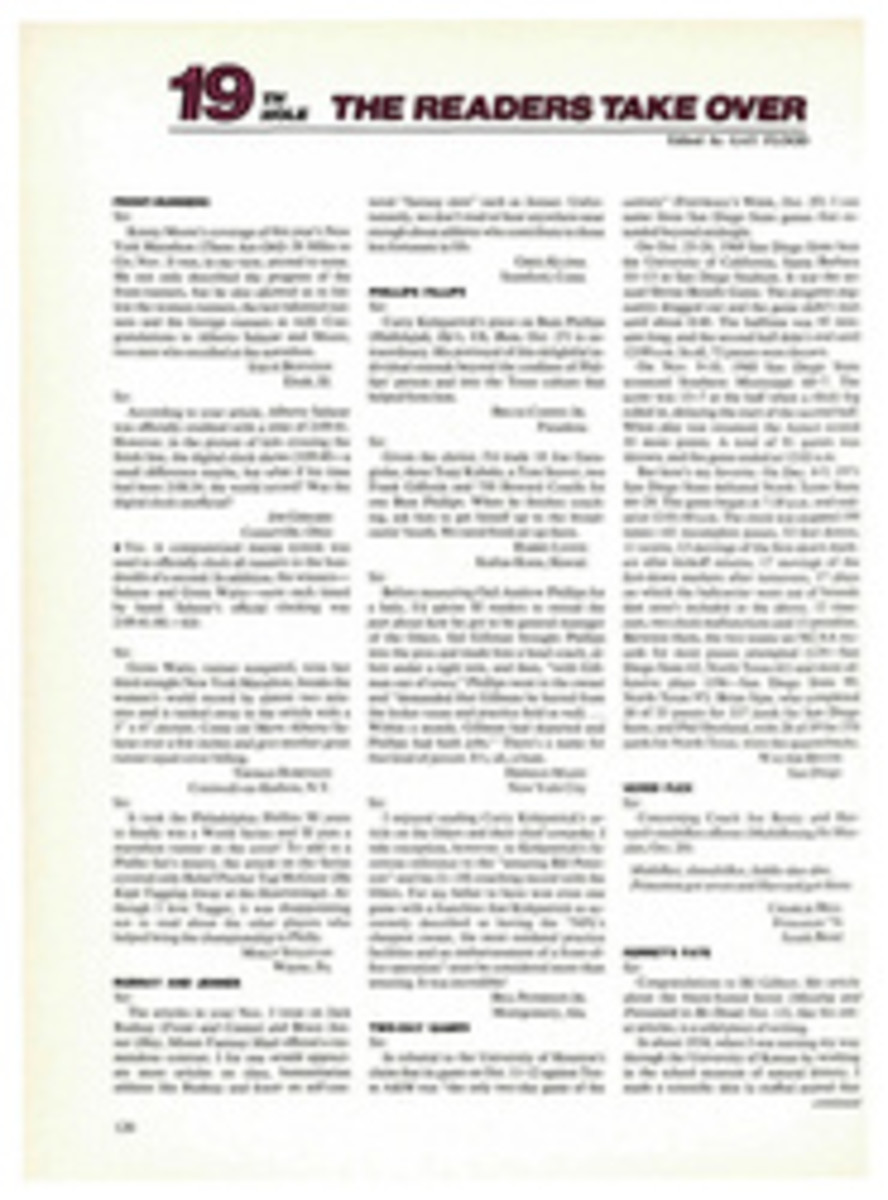
ON HEAVILY TRAVELED SLOPES, FIRST ASCENTS GET TOUGHER AND TOUGHER
John Bouchard and Rick Wilcox are Alpinists who live not in Chamonix or Zermatt but in North Conway, N.H., where only the tallest mountain exceeds 6,000 feet. Such an area might seem to offer slim pickings for a couple of hot climbers like Bouchard and Wilcox, who between them have ascended such classic peaks as Mont Blanc, the Matterhorn, the Eiger (north and west faces), the Petit Dru, Mount Logan in Canada and assorted South American summits.
But while New Hampshire mountains may not be particularly altitudinous, they offer a number of routes that demand superior technical climbing, and Bouchard, Wilcox and others have been able to record first ascents on nearby cliffs that have already been climbed hundreds of times. Obviously, there can be only one first ascent of a mountain, but there are various routes to a given peak, and to be first up an unclimbed route is a gratifying accomplishment. Thus, the first first ascent of the Matterhorn was completed on July 14, 1865 by the Englishman Edward Whymper. And the second first ascent of the Matterhorn came three days later, credited to Jean-Antoine Carrel, who led a team from his native Italian side.
The objective of the original Alpinists was simply to claim an unclimbed peak, and in time, as the neighborhood became climbed out, a mountaineer had to travel farther and farther afield to bag a first ascent. Those who stayed behind, however, were not without sporting alternatives. Original ascents tended to follow the lines of least resistance. The next wave of climbers sought different routes, and inevitably these posed greater challenges.
Early ascents tend to be "aided" (accomplished with pitons, chocks, or bolts used as climbing aids rather than as points for protective belays); they are followed by attempts to climb "free," the climber using only natural holds and cracks, or making the ascent alone, or in winter. That is the usual progression of creditable first ascents. (From time to time nude ascents have been claimed, but that's silly.)
If multiple firsts seem to be a contrivance to keep the game going in perpetual overtime, they do allow succeeding climbers to knock off tougher and tougher climbs and thus get into the record book. But somewhere along the way, someone is bound to declare that finally the game is over, that the mountain's last climbable route has been conquered. Uh huh, and Dewey beats Truman.
It's easy to scale Cannon Mountain in Franconia Notch, N.H. It's only a hill climb, but if that's too strenuous, one can ride to the 4,180-foot summit via a tramway. One side of Cannon, however, presents a genuine test. The mountain's east face is a steep granite wall a mile and a half wide and a thousand feet high, the biggest rock cliffs in the East.
A modern guide to climbing the Cannon cliffs describes no fewer than 70 lines of varying difficulty. Many of these routes were established in the early 1970s, and the one ascended by Bouchard and Wilcox is a fine example of how the umpteenth first ascent of a comparatively modest cliff can be serious business. Bouchard and Wilcox went all the way, and they went in winter.
Bouchard, who is 28, scored his first notable climb in 1971, also on Cannon, as a 19-year-old home from school in France and under oath to his parents not to solo-climb. Promises, promises. But look, Ma, all he did was scale a little 600-foot ribbon of ice in a gully called Black Dike, which Yvon Chouinard had identified the year before as a great unconquered ice climb. That feat made Bouchard something of a Wunderkind, and he kept getting better.
Wilcox, 32, a prudent climber, didn't burst on the scene with Bouchard's flair, but he has made many valorous climbs, too, and has often worked as Bouchard's partner. The two make an effective team, Wilcox' conservative approach tempering Bouchard's explosive style. And they trust each other.
After 1971 several difficult climbs were added to the Cannon itinerary, and then Bouchard and Wilcox decided to up the ante by forcing a new route in winter, which hadn't been done before. To make sure the ascent would be truly significant, they picked a difficult Grade IV line, meaning they would have to spend one night on the cliff face. In January of 1974 they had at it.
Before the actual assault, they pre-climbed the first 300 feet and fixed two ropes in tandem. The rope on the first pitch went up fairly easily. They returned on the last day of 1973 to hang the second rope, but the weather was rough and they worked all day to secure the upper 150 feet.
Five days later they were back. They brought up both fixed ropes behind them, and then Bouchard led the first pitch from the 300-foot level, climbing freely about two-thirds' of the distance, relying on pitons and ètriers (short ladder-like devices with web slings as rungs) the rest of the way. After 150 feet he set a belay, and Wilcox climbed, following Bouchard's lead over a series of steep ice-glazed overlaps and up through a small inside corner. As Wilcox gained altitude he pulled the pitons Bouchard had placed. The rock gave up the metal easily, an indication they were encountering poor cracks.
Wilcox led the next pitch, at least half of it unclimbable except with aid. He belayed at the top of a buttress while Bouchard worked up. The next 75 feet, leading to a sizable terrace, took a tedious hour and ended the day. The climbers pulled up their haul bag, scraped out a hole in the snow and settled into a comfortable bivouac. The temperature was about zero.
In the morning Wilcox led the pitch from the bivouac. Bouchard waited for two hours while Wilcox forced a mixed section of ice and rock, using free and aid techniques, and then hurried up to take the lead himself. He was still finding poor cracks, and near the end of his pitch he reached a crack that wouldn't hold a conventional piton. So Bouchard hammered home a "bong," a piece of metal that resembles a slice of Swiss cheese folded in two. Even that wouldn't grip properly, so he forced it in sideways and climbed past.
When Bouchard ran out of rope, 150 feet above Wilcox, he readied himself to drill a hole for a bolt that would give a solid belay. He fitted a sky hook into a flake of rock just above him and started drilling. Somehow the hook slipped, or a bit of rock broke. What Bouchard remembers is how much it hurt when the hook cracked him in the head as he fell off the cliff.
As he tumbled and bounced down the rock face, the rope tightened on the pitons, and one by one, like a zipper coming apart, they popped loose. Some seven or eight pitons, carrying nearly 20 feet of rope, came flying out of the rock, and then it was the bong's turn. But the bong held, and the falling Bouchard came to a jarring stop after 40 feet. It had cost him, though—somewhere during the fall Bouchard had cracked his right ankle against a rock and he sensed that it was broken.
Slowly he reclimbed past the life-saving bong, replacing pitons and moving up on the ètriers. He had nearly regained his highest point when a gust of wind tipped him over. This time he fell only 10 feet, but he yelled to Wilcox that he couldn't complete the pitch.
Wilcox shouted back that Bouchard had to go up and finish the bolt hole. Again, despite the pain from torn ligaments (as the ankle injury proved to be), Bouchard inched up, hung in and began drilling. With his good leg lodged in a rung of the ètriers, Bouchard dangled in the wind and hammered for 20 minutes to make a hole an inch deep. He placed the bolt, fixed an eye on the protruding end and clipped the rope into it with a carabiner. His first fall had occurred at noon; when he finally clipped into the bolt it was after two o'clock. He was 50 feet below the top of the cliff.
Using the bolt as an anchor, Wilcox, from below, lowered Bouchard about as far as he had fallen and then told him to start penduluming—stepping back and forth horizontally on the rock—until he had generated enough swing to reach a tiny ledge to the left.
Hurrying carefully, Wilcox went up to Bouchard's painfully gained bolt to retrieve the pitons. Then he lowered himself and swung onto the ledge with Bouchard. It was three o'clock and daylight was already dimming.
The way off, Wilcox decided, was a long 300-foot left traverse to the wooded upper flanks of the mountain. As he stepped across the ledge and along precious footholds he knocked in pitons, one about every 10 feet, and clipped his rope into them. After 150 feet, one rope length, he signaled Bouchard to come across. Unable to put weight on his right ankle, Bouchard fell from one piton to the next, scrambling up after each slip and creating what may have been another Cannon first—the scalloped traverse.
After he caught up to Wilcox, they made another 150 feet in much the same fashion and, at five o'clock, came off the rock. They had a first ascent.
On the last stretch of the descent, Wilcox dragged the injured Bouchard after him. On occasional flat stretches, Bouchard dragged himself, crawling on his hands and knees through deep snow. When they reached the highway, Wilcox got their car and drove Bouchard to the hospital in North Conway, more than an hour away.
First ascenders are expected to christen their routes. Wilcox named theirs Icarus, with the comment that Bouchard was too near the sun and shouldn't have tried to fly.
It is believed that no one has since repeated Icarus, or even tried, and that's another thing about first ascents. Sometimes once is enough.
ILLUSTRATION

